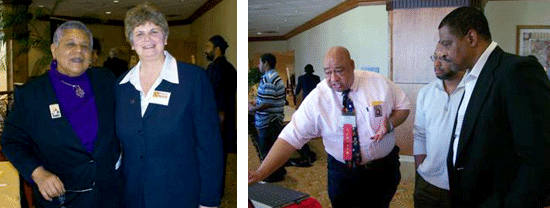LITTLE ROCK, AR—Representatives from the First In Math® program attended the inaugural Conference on the Mathematics Teaching, Learning, and Research of African American Students November 13-14. The 2008 conference, sponsored by the Benjamin Banneker Association, was titled "Unlocking the Doors of Excellence in Mathematics for African American Students."
"The conference was a wonderful way for teachers and exhibitors to share ideas and work on mathematics excellence, including ways to close the achievement gap," says FIM Support Specialist Nancy Kane. FIM Ambassador Cred Dobson, agrees, adding "The professional excellence of this event was a thing of beauty—kudos to Conference Chair Vanessa Cleaver."

Left: Minnijean Brown-Trickey and Nancy Kane. Right: Cred Dobson demos FIM to several educators
There were dozens of workshops, a panel discussion featuring Dorothy Strong, and Dobson's own presentation, titled: "First In Math - A Proven, Innovative Online Program." Dobson maintains that the highlight of the conference was meeting Minnijean Brown-Trickey, one of the "Little Rock Nine" who helped desegregate Little Rock Central High School in 1957. According to Dr. Lou Edward Matthews, Editor-in-Chief for the Journal of Urban Mathematics Education and President of the Benjamin Banneker Association, “The conference was inspirational for us all! In the span of 48 hours we bonded together as a family—the Little Rock 300. This is what movements are made of.”
Benjamin Banneker was born in Maryland in 1731. The son of a former slave, Banneker did not let race nor age hinder his quest for intellectual development. He was a farmer, scholar, mathematical wizard, astronomer and surveyor. At age 58, Banneker taught himself the science of astronomy; making projections for solar and lunar eclipses and computing tables on the locations of celestial bodies for almanacs. Also a social activist, Banneker wrote a long letter to then Secretary of State Thomas Jefferson—in which he made a case for equality for African Americans—that was given wide publicity. In 1980, the U.S. Postal Service issued a postage stamp to honor his achievements as the first African American scientist.